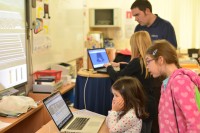Outreach: supercomputing dinosaurs at Bang Goes the Borders

EPCC, the supercomputing centre based in the School, took part in Bang Goes the Borders, a free science festival held in St Mary's Primary School in Melrose. EPCC's Mario Antonioletti reviews the day.
This was my first time at Bang Goes The Borders, but my fellow EPCC'ers Iain Bethune and Terry Sloan were old hands, both having done it last year. We set up four stands in a classroom we were allocated, with the first overseen by Terry who ran two exercises showing the benefits of using parallelism to solve problems.
Parallelism games
Terry’s first demonstration asked volunteers to sort balls according to colour. A single person, usually a child, is asked to see how many balls they can sort in a minute, then the task is repeated with more than one person. In nearly all cases the task can be done more quickly with more people, ergo you can use multiple processors to solve a problem faster. The ball-sorting usually works very well as it gets the naturally competitive nature of kids going.
There was also a card-sorting demonstrator, which is a little bit more involved as it requires coordination between the "processors" so is more suitable for a slightly older age group.
Hardware
Having demonstrated the benefit of parallelism, I showed attendees a number of processor boards of previous machines that have been hosted by EPCC - there was a Thinking Machines CM-200 board, a Cray T3E board (which was liquid-cooled), a Cray XT board and, to compare them with something that might be more familiar and found at home, the insides of a Dell desktop.
There was some interest among the audience in all of this, but perhaps not so much for the younger age group who were more attracted by the aesthetics of the component arrangement, liked poking about the exposed electronics or trying to lift the Cray T3E board, and were fascinated by its heaviness.
The hope was that having experienced the benefit of working in parallel, actually seeing the boards with multiple processors would link the two experiences together.
A third desk had a rolling presentation of the types of problems that are typically run on such massively parallel systems - from climate modelling and computational biochemistry to fluid dynamics and cosmology!
Close to this was the freebies desk which was the second most popular spot, second only to the dinosaur racing.
Dino racing
By far the biggest crowd puller for us was the dinosaur racing, with a mass of people surrounding Iain at the stand. This was the second outing for this Virtual Palaeontology demo: on the EPCC blog you can read about its British Science Festival 2013 (BSF13) debut and about EPCC's presence at BSF13. A number of improvements and fixes were done post-BSF13, which further enhanced the activity. The demo was run off a node on HECToR so people were also able to use a supercomputer. Many kids came back several times during the day to try to improve on their first dinosaur design.
It is difficult to determine how many people saw our stands, although the organisers estimated that numbers were up 20-40% over last year, with over a thousand people circulating through the entire event. Certainly we must have given several hundred their first hands-on experience of supercomputing! It was a long and exhausting day, but we hope that some of the young people who visited our classroom will go on to do science in later life and, who knows, may even come to work at EPCC.
You can find out more about EPCC's work, including its outreach activities, on the EPCC blog.
Photography by Mario Antonioletti and Keith Morgan.

